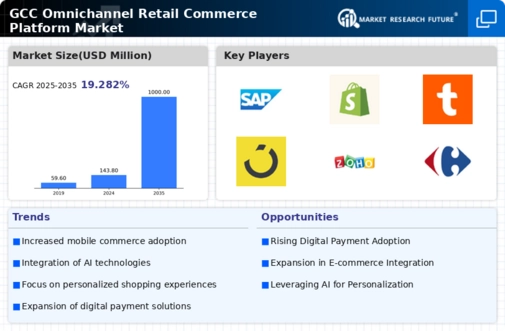The omnichannel retail-commerce-platform market is currently characterized by a dynamic competitive landscape, driven by rapid technological advancements and evolving consumer preferences. Key players such as Amazon (US), Alibaba (CN), and Walmart (US) are at the forefront, each adopting distinct strategies to enhance their market positioning. Amazon (US) continues to innovate through its extensive logistics network and advanced AI capabilities, focusing on personalized shopping experiences. Meanwhile, Alibaba (CN) emphasizes its stronghold in the Asian market, leveraging its vast ecosystem to integrate e-commerce with social media and digital payments. Walmart (US), on the other hand, is enhancing its omnichannel capabilities by investing in physical store integration and expanding its online offerings, thereby creating a seamless shopping experience for consumers. Collectively, these strategies contribute to a competitive environment that is increasingly focused on customer-centric solutions and technological integration.
In terms of business tactics, companies are increasingly localizing their operations and optimizing supply chains to enhance efficiency and responsiveness. The market appears moderately fragmented, with a mix of established giants and emerging players vying for market share. The collective influence of these key players shapes the competitive structure, as they engage in strategic partnerships and collaborations to bolster their market presence and operational capabilities.
In October 2025, Amazon (US) announced the launch of its new AI-driven shopping assistant, designed to enhance customer engagement and streamline the purchasing process. This strategic move underscores Amazon's commitment to leveraging technology to improve user experience and drive sales. The introduction of this assistant is likely to further entrench Amazon's position as a leader in the omnichannel space, as it aligns with current consumer expectations for personalized and efficient shopping solutions.
In September 2025, Alibaba (CN) expanded its logistics network by partnering with local delivery services across the GCC region. This initiative aims to reduce delivery times and enhance service reliability, which is crucial in meeting the demands of the increasingly impatient consumer base. By strengthening its logistics capabilities, Alibaba is positioning itself to capture a larger share of the market, particularly in regions where rapid delivery is a key differentiator.
In August 2025, Walmart (US) unveiled its new sustainability initiative, which includes a commitment to reduce carbon emissions across its supply chain by 30% by 2030. This strategic focus on sustainability not only addresses growing consumer concerns but also enhances Walmart's brand image as a responsible retailer. The initiative is expected to resonate well with environmentally conscious consumers, potentially driving loyalty and increasing market share.
As of November 2025, the competitive trends in the omnichannel retail-commerce-platform market are increasingly defined by digitalization, sustainability, and the integration of AI technologies. Strategic alliances are becoming more prevalent, as companies recognize the need to collaborate to enhance their capabilities and market reach. Looking ahead, competitive differentiation is likely to evolve from traditional price-based competition to a focus on innovation, technological advancements, and supply chain reliability. This shift suggests that companies that prioritize these areas will be better positioned to thrive in an increasingly complex and competitive landscape.

















Leave a Comment